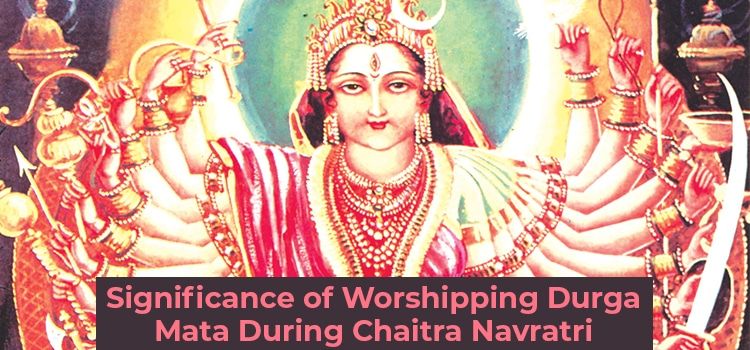Goddess Durga or Shakti is the Supreme Goddess and protective mother of the universe in Hinduism. She is a very popular deity who wages battle against evil forces who threaten peace and harmony.
Durga is a Sanskrit word meaning “a fort that cannot be crossed over.” It evokes her militant and protective qualities. She is also called Durgatinashini, which literally means “the one who eliminates sufferings.”
Durga has many avatars like Kali, Bhavani, Bhagvati, Ambika, Gauri, Lalita, Kandalini, Java, and Rajeswari.
When she appears as herself, she manifests in these 9 forms – Skandamata, Kushmanda, Shailaputri, Kalaratri, Brahmacharini, Mahagauri, Katyayani, Chandraghanta, and Siddhidatri. Together, they form the Navadurga.
Navratri and Goddess Worship
The Navratri festival is one of the biggest religious festivals in India, and it is dedicated to Goddess worship. Navratri literally means ‘9 nights.’ There are 4 Navaratris in a year, but Chaitra Navratri/Vasant Navratri and Sharad Navratri are the most important. The other two are Ashada Navratri and Magha Navratri.
Chaitra Navratri occurs during the spring season in Chaitra month (March-April). The festival honors Goddess Durga and celebrates the triumph of good over evil.
History of Chaitra Navratri
According to popular belief, Lord Shiva allowed his wife Parvati or Durga to visit her parent’s house for nine days. During this time, the goddess supposedly killed the buffalo-headed demon Mahishasura, ensuring the victory of good over evil. Worshipping Durga gives inner strength or shakti to the devotees as they know that she will protect them from all harm. During Navratri, many Hindu women also visit their maternal homes.
Significance of Chaitra Navratri
This nine-day festival commemorates the victory of good over evil forces. The demon Mahishasura is a symbol of the negative energies that lurk within us. These include our ego and feelings like pride, envy, jealousy, hatred, greed, lust, etc. When we harbor such feelings within us, we cannot become one with God. Such things actually separate us from God.
Navratri is a time to cleanse ourselves of negativity and surrender to the Supreme Goddess. It’s the reason why many people observe a fast on all 9 days of Navratri. Fasting is a way to purify the mind and body so that one can focus on the deity who is being worshipped. It also pleases the deity.
Worshipping Goddess Durga gives us the strength and courage to overcome our problems. It can also bring wish-fulfillment and salvation.
Chaitra Navratri comes in March or April. Chaitra is the 1st month in the Hindu calendar. It heralds the beginning of spring season when new life springs forth on earth.
The Astrological Significance of Navratri
The festival is significant in astrology as the Sun signs or zodiac signs begin to change from Chaitra Navratri. The Sun completes his journey in the 12 zodiac signs and re-enters the first zodiac, Aries, to start the next cycle.
Major Facts about Chaitra Navratri
Chaitra Navratri begins with Pratipada of Shukla Paksha, the waxing lunar phase. The Brahma Purana says that Brahma began the creation of the Universe from Chaitra Pratipada. The calendar of the Hindu New Year is counted from this festival onwards. Some believe that Durga descended on the first day of Chaitra Navratri and told Brahma to begin the task of creation.
Hence, the Hindu New Year commences with Chaitra Shukla Pratipada.
Also, on the third day of this Navratri, Lord Vishnu supposedly took his first avatar or incarnation, Matsya. As Matsya, a big fish, he rescued the Vedas from the sea. He also rescued Manu, his wife, Shatarupa, the Saptarishis, and one set each of all the living beings. After Shiva had destroyed the world, which had fallen into moral decay, the world was recreated again from the human beings and animals who were rescued.
Lord Rama, the 7th incarnation of Vishnu, was also born on Navami day (9th day) of Chaitra Navratri. Hence this day is celebrated as Ram Navami.
Navratri and the 9 Chakras
The human body has 9 chakras or energy centers. Seven of these lie within the body, and two lie outside. The 9 chakras are associated with 9 divine powers. Navratri is the time to harmonize and integrate the internal and external chakras.
A Time for Self-purification
Navratri’s 9 days are associated with 3 purification cycles. Each purification cycle is divided into 3 cycles of 3 nights symbolically.
Goddess Durga represents the first cycle. Here, the purification occurs mostly in the physical world, namely the vital energy body and the physical body. So devotees observe a fast during this time.
Goddess Lakshmi represents the second cycle. This cycle aims to purify the emotions. It is connected to the subtle or astral body. Through fasting and meditation, we can remove the emotional knots.
Goddess Saraswati represents the third cycle. It enables us to purify the mind at the deepest level by removing our false beliefs. Both the mental/spiritual body become pure in this cycle.
Importance of Durga
Durga is the mother of all creation, the Cosmic Mother. She embodies compassion and kindness. She also represents time – past, present, and future – as well as the three worlds – physical, mental, and transcendental. She is present everywhere as material, energy, and consciousness.
She is one with Shiva and the primordial sound OM. In the material world, karma is the instrument for punishing evil-doers. Durga’s duty is to purify those who are sinful. For this reason, Navratri has a special and hallowed place in the minds of Hindus.









Comments & Discussion
5 COMMENTS
Please login to read members' comments and participate in the discussion.